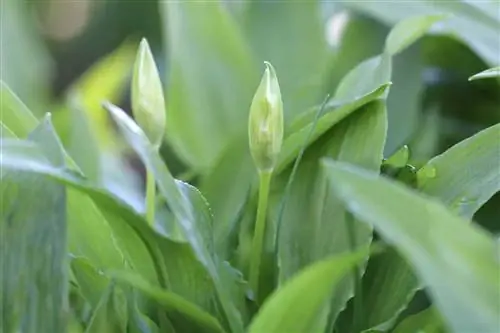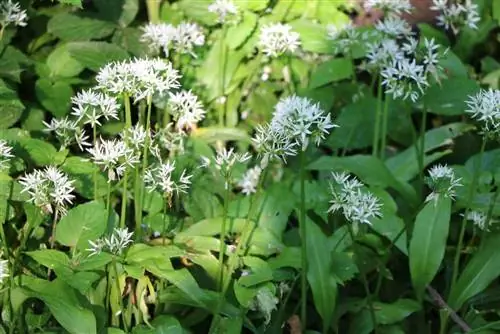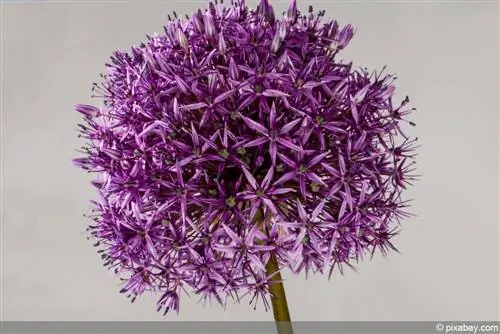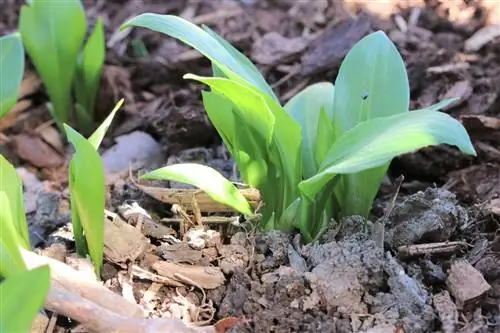- Author admin [email protected].
- Public 2023-12-17 03:39.
- Last modified 2025-01-24 12:45.
Wild garlic occurs wild in nature, but the plant can also be grown in the home garden. Over time, the opinion has become established that wild vegetables should no longer be consumed once they are in bloom, as they then become poisonous. However, this theory is not entirely correct, although a lot of things change in taste as the flowers begin to bloom.
Edibility
Wild garlic is a local plant and has a particularly delicate and spicy flavor that is subtly reminiscent of garlic. Fresh wild garlic leaves are particularly suitable for salads. Since growing wild garlic is relatively easy, it can also be found in many home gardens. The spicy plant grows wild in the local forests and is mainly found on the edges of fields. Over time, a rumor has spread that wild garlic is poisonous during and after flowering. However, this is not the truth, not a single component of wild garlic is poisonous, regardless of the season and the state of the flowers. However, there are big differences in quality depending on when the wild vegetables are harvested.
- Also called wild garlic
- All parts of the plant are safe to consume
- No matter what time of year they are harvested
- Young and fresh leaves have the most intense flavor
- Flowers are also spicy and edible
- Can be used just like the leaves
- However, leaves from flowering plants no longer taste as good
- Leaves become fibrous and unsightly as flowering begins
Flowering time
Wild garlic is one of the most popular spring herbs and begins to develop its leaves and flowers very early. Since wild garlic looks very similar to many other plants, some of which are poisonous, caution is advised. Therefore, a sample should be taken before consumption to make sure that it is actually the desired wild vegetable. To do this, rub a leaf firmly between your fingers. If a garlic-like smell arises, then it is definitely wild garlic. If this is not the case, then it is better not to eat the plant.
- Flowering season begins in April
- White inflorescences then form
- Flowers grow in a star shape
- Also have a spicy flavor
- As the flowering period progresses, the aroma of the leaves migrates into the flowers
- Flowers can be used as decoration for food
Harvest

Wild garlic is one of the earliest wild plants to be collected throughout the year. If it grows in a protected place in the garden, it will develop its spicy-tasting leaves at the beginning of spring. Theoretically speaking, wild garlic can be harvested from spring to autumn because the plant is not poisonous at any time of the year. Although the rumors are persistent, they do not correspond to the facts. Even after flowering, the wild vegetables are still edible. However, harvesting wild garlic should take place before or during the flowering period, as leaves become more fibrous after flowering and gradually lose their taste. Freshly harvested leaves only last a few days, but with the right methods they can be preserved for later consumption.
- In many places the first tender leaves appear at the beginning of March
- Ideal harvest time is from March to early May
- Harvest in the early morning hours, then the leaves are particularly juicy
- Just collect from large stocks
- Harvest only one or two leaves per plant
- Cut off the leaves and don't tear them out brutally
- Protect plants and don't trample them unnecessarily
- Collect in nature away from paths
- Can be preserved by freezing and drying
- It is also possible to pickle it in vinegar or oil
Tip:
If the wild garlic leaves are wrapped in a damp tea towel after harvesting, they will stay fresh and flavorful in the refrigerator for up to a week.
Nature conservation
It's best to grow wild garlic yourself and just pick your own wild garlic. If you want to harvest wild garlic in the wild, it's not that easy and a few rules must be followed.
IMPORTANT:
If the wild garlic is in a nature reserve or protected area, there is an absolute ban on picking!
As with all wild plants (mushrooms, wild berries, wild herbs) there is a need for a “reasonable reason” to take something from nature. A recognized reason includes, among other things: "Hunger". That's why you should only pick as much as you really need without destroying the plant. So that the wild garlic is not affected, you should not harvest more than one leaf per plant so that it can continue to live.






